
Herpers' Guide
Unique Pets for Unique People!
Who are the herpers?
Take a tour of some of the most popular pet herp species
And here is a look at some species that are commonly available, but not suggested for beginners
Dog or cat or bird or sugar glider owners are often surprised to find that people interested in snakes, toads, turtles and lizards are just as enthusiastic about their creeping, slithering and burrowing pets as any golden retriever or macaw owner is about his or her own favorite pet - maybe even more so!
If you are not familiar with these enthusiasts, there are roughly two categories of “herp” aficionados: 1) pet owners and 2) breeders. 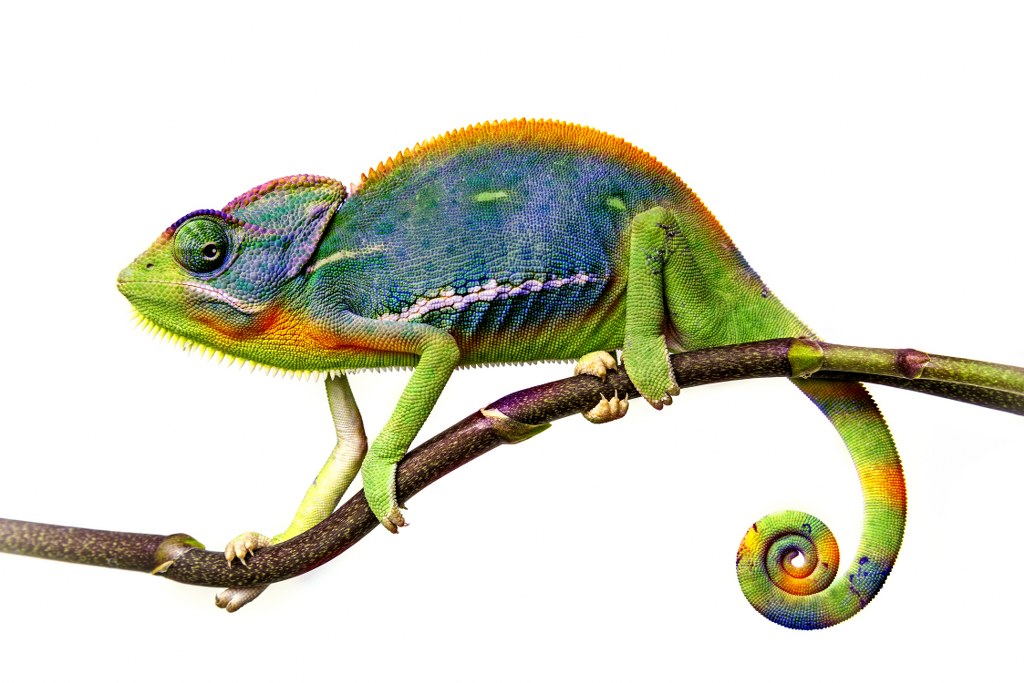 Pet owners usually have one or two reptiles or amphibians, and consider them as their personal household pets, while breeders (who usually started out as pet owners), don’t regard each of their animals - 100 breeder leopard geckos - as individual pets, for instance. Pet owners as well as breeders recognize that individuals under their care may have personality characteristics, but breeders focus more on the study, preservation, propagation and protection of the particular species they have chosen to steward. And by the time they reach a breeder level of interest, many have accumulated a massive amount of information about their subjects – information, data and handling practices that rival higher education zoology studies and new discoveries that stay abreast with the most current animal research efforts. In fact, many serious private herp enthusiasts are more knowledgeable on many aspects of the biology of these animals than highly recognized professionals. This is due to years of personal, hands on, day-to-day interaction with the animals that many professionals may have missed out on while learning about these animals mainly through published material or less intensive “in the trenches” experience.
Pet owners usually have one or two reptiles or amphibians, and consider them as their personal household pets, while breeders (who usually started out as pet owners), don’t regard each of their animals - 100 breeder leopard geckos - as individual pets, for instance. Pet owners as well as breeders recognize that individuals under their care may have personality characteristics, but breeders focus more on the study, preservation, propagation and protection of the particular species they have chosen to steward. And by the time they reach a breeder level of interest, many have accumulated a massive amount of information about their subjects – information, data and handling practices that rival higher education zoology studies and new discoveries that stay abreast with the most current animal research efforts. In fact, many serious private herp enthusiasts are more knowledgeable on many aspects of the biology of these animals than highly recognized professionals. This is due to years of personal, hands on, day-to-day interaction with the animals that many professionals may have missed out on while learning about these animals mainly through published material or less intensive “in the trenches” experience.
So what kinds of “herps” do pet owners typically start with or own? It depends. Just as dog owners have different interests and reflect them in preferring a Chihuahua or Heinz 57 mixed-breed dog over a St. Bernard, herpetology folks, (known as “herpers”) may prefer big snakes like anacondas to smaller species like corn snakes or ball pythons. And some herpers work solely with geckos, while others are frog people. Space and financial considerations may be constraints for beginners, but fascination and focus drive the choices. In any case, recommendations for beginners should center around smaller and easily manageable species that are commonly bred and have been kept as pets for decades. A few examples of good beginner species can be found below.
Even before someone brings home a reptile, they begin a learning process that prompts them to know “beginner” stuff about their pets: their native range and climate; how long they live; natural and captive biology activities and environmental needs – everything that is necessary to keep an animal as a pet for anywhere from 4 to 40 or more years. They also become aware of specific husbandry needs that may not be suited to first-time herp owner excursions, or just basic size issues that may make beginner ownership too much of a challenge. For people who have grown up with a dog or cat, herps as pets may seem like an odd notion; however, beginner herpers notice personality traits and characteristics of their individual pets, much as any dog or cat or bird owner will note the inclinations and activities and communication methods of their own.
Snakes anyone? How many boa constrictor subspecies are there and where do they come from? Details on care, natural range, taxonomy and genetics can be found for boas at Goss Reptiles.
Anyone thinking of acquiring a herp should consider the following characteristics of each animal before making their choice:
_751x517.jpg) Leopard Gecko (Eublepharis macularius): A small fat-tailed lizard native to Pakistan, Afghanistan and India. They grow to a total length of 7-11 inches and live for 6-20 years and require moderate-sized caging. For up to 3 adults, terrariums should be 30“x 12” with screened top and varied heating. Reptile sand or other non-impaction causing substrate, water bowl, a hiding place and a branch or low climbing structure are essentials. Three adults means one male and two females or three females: 2 males should not be housed together. If their environment is well prepared, they require minimal maintenance, involving quick feedings and cage spot cleaning. Care must be taken when handling as leopard geckos can drop, or detach, their tails. They’re quiet, don’t have an offensive odor and they are easy keepers. They come in a variety of colors and are an excellent choice for a beginner reptile pet owner.
Leopard Gecko (Eublepharis macularius): A small fat-tailed lizard native to Pakistan, Afghanistan and India. They grow to a total length of 7-11 inches and live for 6-20 years and require moderate-sized caging. For up to 3 adults, terrariums should be 30“x 12” with screened top and varied heating. Reptile sand or other non-impaction causing substrate, water bowl, a hiding place and a branch or low climbing structure are essentials. Three adults means one male and two females or three females: 2 males should not be housed together. If their environment is well prepared, they require minimal maintenance, involving quick feedings and cage spot cleaning. Care must be taken when handling as leopard geckos can drop, or detach, their tails. They’re quiet, don’t have an offensive odor and they are easy keepers. They come in a variety of colors and are an excellent choice for a beginner reptile pet owner.
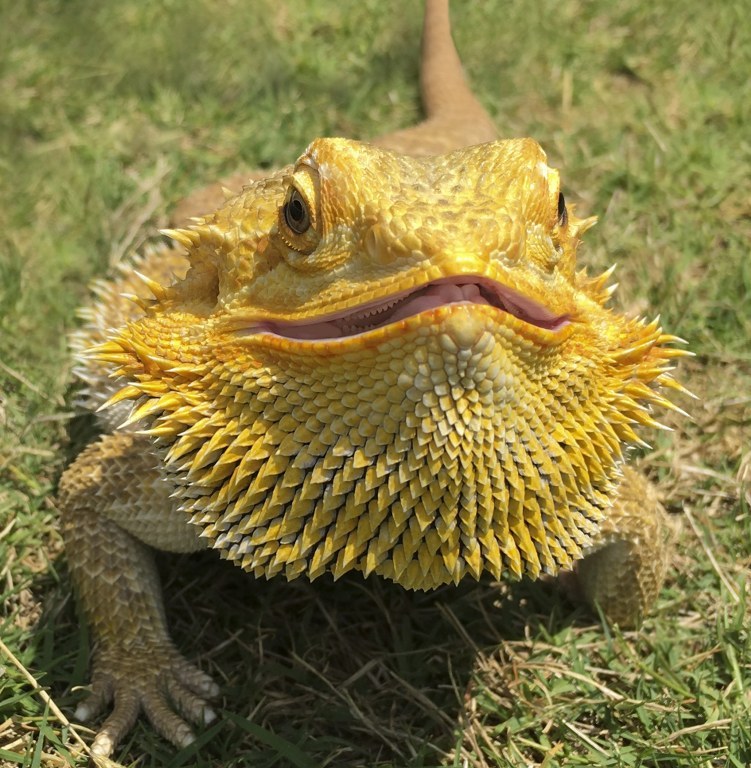 Bearded Dragon (Pogona vitticeps): A lizard from Australia, bearded dragons live 6-15 years and grow to 12-24” long, subsisting on a varied omnivore diet. Caging should be at least a 36”x 18” screen-topped terrarium, which can house 2 females or a mated pair, and should have logs or rock basking areas. They have specific heat and light requirements, including UVB lighting 10-14 hours a day, and also need calcium and vitamin supplements. The young eat almost insatiably. The cage day temperature should be between 79-83 degrees, with a basking area of 95-105 degrees. Their scales look sharp, but are soft and flexible. Their care, lighting, heat and diet requirements put them into the beginner to moderately experienced category for owners. More information on Bearded Dragon Care
Bearded Dragon (Pogona vitticeps): A lizard from Australia, bearded dragons live 6-15 years and grow to 12-24” long, subsisting on a varied omnivore diet. Caging should be at least a 36”x 18” screen-topped terrarium, which can house 2 females or a mated pair, and should have logs or rock basking areas. They have specific heat and light requirements, including UVB lighting 10-14 hours a day, and also need calcium and vitamin supplements. The young eat almost insatiably. The cage day temperature should be between 79-83 degrees, with a basking area of 95-105 degrees. Their scales look sharp, but are soft and flexible. Their care, lighting, heat and diet requirements put them into the beginner to moderately experienced category for owners. More information on Bearded Dragon Care
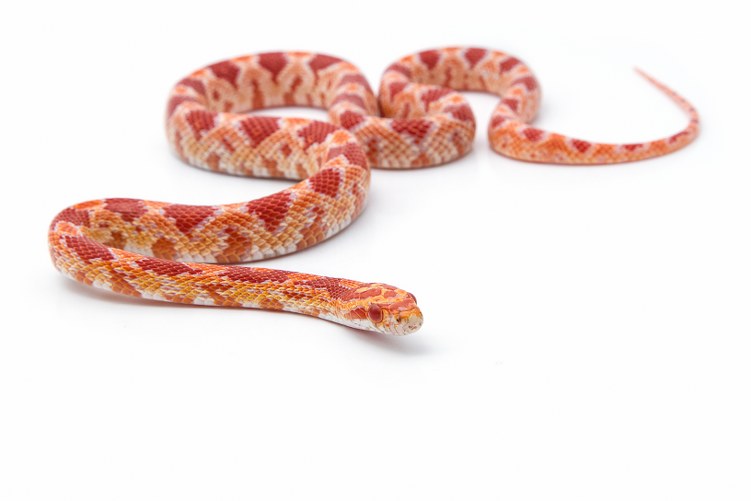 Corn Snake (Elaphe guttata): Found in the southeastern US, corn snakes usually grow 3’-5’ in length and have a life span of 15-25 years. They’re able tree climbers, diurnal (daytime active) and need hiding spots in their caging, which should be no smaller than 30”x12” with secure screened covers. They’re constrictors, catching their prey with a bite and wrapping around with coils. Corn snakes are not daily feeders. In captivity, a meal is usually given once every 7-10 days. Sometimes called the red rat snake, they help to control rodent populations in the wild. Temperature and humidity concerns are moderate. They are one of the most frequently bred snakes for pet purposes. Read more about corn snake care here.
Corn Snake (Elaphe guttata): Found in the southeastern US, corn snakes usually grow 3’-5’ in length and have a life span of 15-25 years. They’re able tree climbers, diurnal (daytime active) and need hiding spots in their caging, which should be no smaller than 30”x12” with secure screened covers. They’re constrictors, catching their prey with a bite and wrapping around with coils. Corn snakes are not daily feeders. In captivity, a meal is usually given once every 7-10 days. Sometimes called the red rat snake, they help to control rodent populations in the wild. Temperature and humidity concerns are moderate. They are one of the most frequently bred snakes for pet purposes. Read more about corn snake care here.
_751x501.jpg) Milk Snake (Lampropeltis species): These snakes are found from Canada and the eastern U.S. all the way down to Venezuela. They are found in forested areas as well as in some prairies and rocky landscapes. They usually grow from 2’-5’ depending on their species and live for 10-20 years. Species can vary greatly in appearance, with even the same species being highly variable across its range. In captivity, you can find a variety of morphs, or different colors and patterns. Nearly all have spectacular bands of alternating colors that set them apart, but that also can cause erroneous identification as venomous coral snakes. For coral snakes, remembering the sayings “Red touches black, you’re OK Jack” or “Red touches yellow, you’re a dead fellow” help keep encounters in the wild from going very badly. They are also sometimes confused with massasauga rattlesnakes because of the segmented coloring. Milk snakes are harmless pets, though. They are nocturnal and are known to be very good at slipping out of inappropriate caging. Their environmental needs are moderate, with temperatures on the warm end of the cage recommended at 84-90 degrees, with 70-75 degrees on the cool end. Lighting cycles of 12 hours on, 12-off are suggested. Clean water should be available at all times. Adults should be kept in cages with a footprint of at least 30" x 12", but larger specimens of some species will require more room. They are among the most popular snakes for beginning herpers. Read more about milk snakes care here.
Milk Snake (Lampropeltis species): These snakes are found from Canada and the eastern U.S. all the way down to Venezuela. They are found in forested areas as well as in some prairies and rocky landscapes. They usually grow from 2’-5’ depending on their species and live for 10-20 years. Species can vary greatly in appearance, with even the same species being highly variable across its range. In captivity, you can find a variety of morphs, or different colors and patterns. Nearly all have spectacular bands of alternating colors that set them apart, but that also can cause erroneous identification as venomous coral snakes. For coral snakes, remembering the sayings “Red touches black, you’re OK Jack” or “Red touches yellow, you’re a dead fellow” help keep encounters in the wild from going very badly. They are also sometimes confused with massasauga rattlesnakes because of the segmented coloring. Milk snakes are harmless pets, though. They are nocturnal and are known to be very good at slipping out of inappropriate caging. Their environmental needs are moderate, with temperatures on the warm end of the cage recommended at 84-90 degrees, with 70-75 degrees on the cool end. Lighting cycles of 12 hours on, 12-off are suggested. Clean water should be available at all times. Adults should be kept in cages with a footprint of at least 30" x 12", but larger specimens of some species will require more room. They are among the most popular snakes for beginning herpers. Read more about milk snakes care here.
NOTE: If you cannot positively identify a snake, never interact with it. The coral snake/milk snake rhyme only works for specimens found in the United States. Also, some localities of milk snakes may have off-white and yellowish bands.
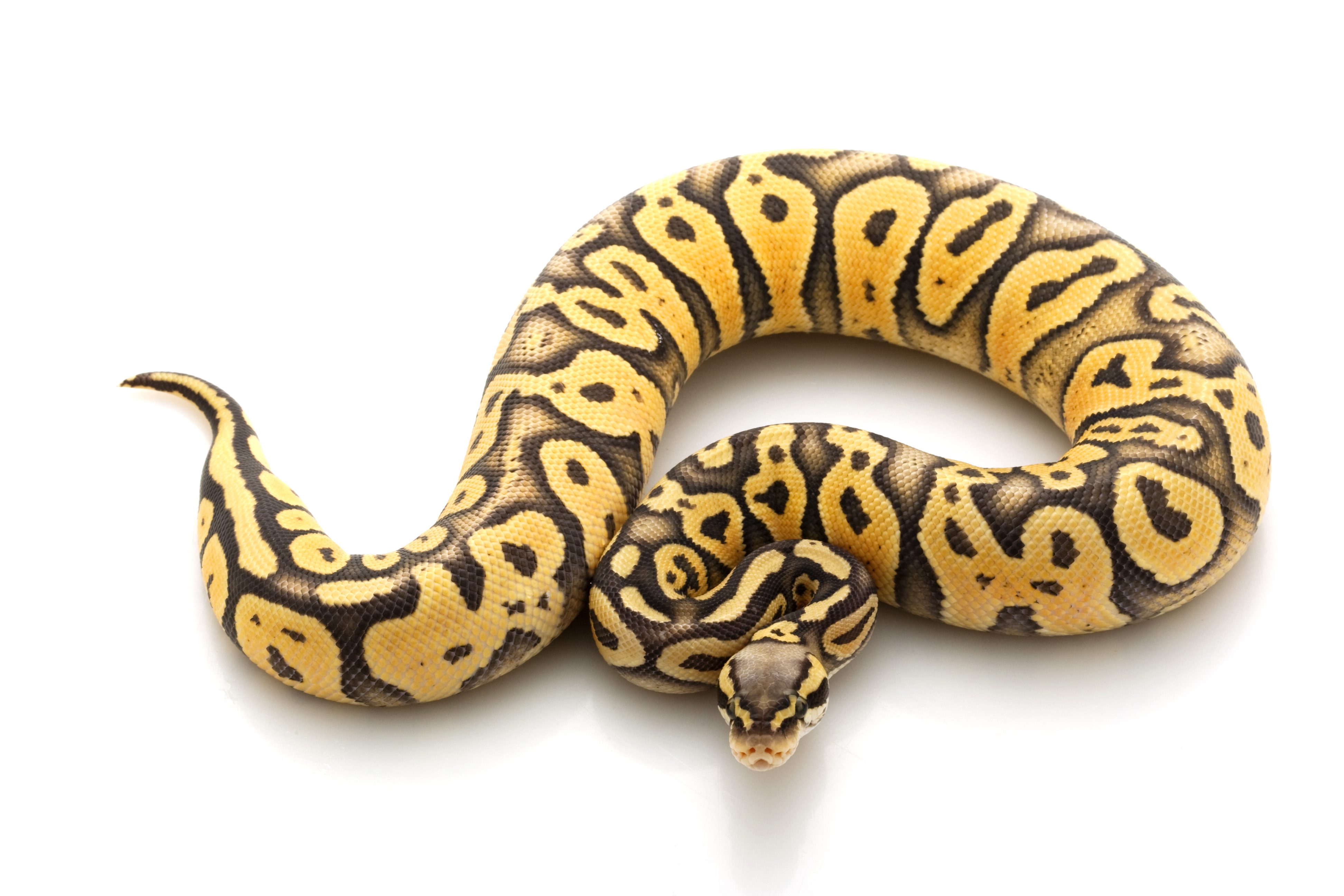 Ball python (Python regius): From western and central Africa, ball pythons usually grow to 3’-5’ and have a life span of 15+ years. They are classified as a good beginner herp pet and come in a staggering array of morphs, or color and pattern variations, with beautiful markings. Their name comes from their tendency to curl up into a tight ball if nervous or threatened. Their formal name of Python regius translates to “Royal Python” and is thought to have come from the belief that Cleopatra wore one around her wrist as a bracelet. Adults need a minimum of 30”x12” cage space with hiding places, and floor space is more important than climbing areas, as they’re terrestrial snakes. Substrate usually consists of cypress mulch, fir bark, shaved aspen or cage carpet. They need an environment humid enough to sufficiently shed and a water bowl large enough to submerge. Humidity should be in the range of 60%-80% and may require misting to get to proper levels, especially during shedding cycles. Cages are normally heated from below, known as belly heat, with the hot side of the cage at 88-92 degrees and the cool end of the enclosure at 75 degrees. They feed as babies and juveniles every 7-10 days, and as adults every 7-14 days. Read more about ball python care here.
Ball python (Python regius): From western and central Africa, ball pythons usually grow to 3’-5’ and have a life span of 15+ years. They are classified as a good beginner herp pet and come in a staggering array of morphs, or color and pattern variations, with beautiful markings. Their name comes from their tendency to curl up into a tight ball if nervous or threatened. Their formal name of Python regius translates to “Royal Python” and is thought to have come from the belief that Cleopatra wore one around her wrist as a bracelet. Adults need a minimum of 30”x12” cage space with hiding places, and floor space is more important than climbing areas, as they’re terrestrial snakes. Substrate usually consists of cypress mulch, fir bark, shaved aspen or cage carpet. They need an environment humid enough to sufficiently shed and a water bowl large enough to submerge. Humidity should be in the range of 60%-80% and may require misting to get to proper levels, especially during shedding cycles. Cages are normally heated from below, known as belly heat, with the hot side of the cage at 88-92 degrees and the cool end of the enclosure at 75 degrees. They feed as babies and juveniles every 7-10 days, and as adults every 7-14 days. Read more about ball python care here.
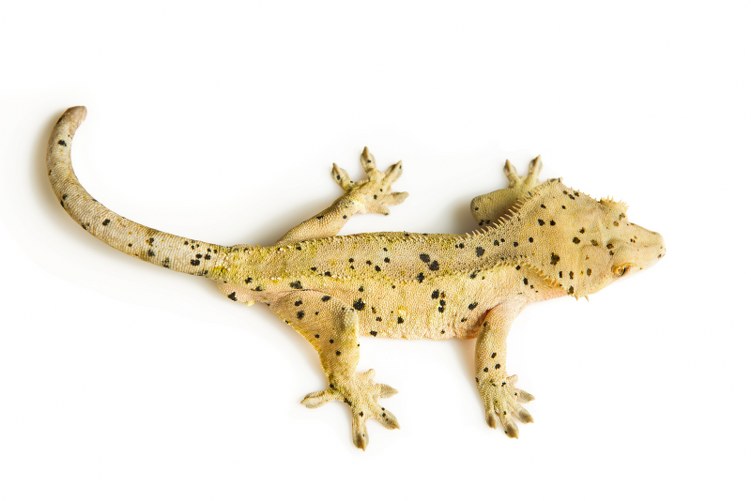 Crested Gecko (Correphalus ciliatus, formerly Rhacodactylus cilitaus): From the New Caledonian islands near Australia, these geckos were thought to be extinct until 1994, but they are common in captivity and have adapted readily to captive care. They are excellent first choices for a beginning herper. Cresteds are omnivores and must be kept at lower temperatures than many other reptile species, as New Caledonia has a very stable tropical climate. A range of 72-78 degrees is preferred. They are relatively easy to handle and require moderate caging systems. They do need climbing accommodation, though, so the caging should be tall, and should include hiding places. They also come in a beautiful variety of colors and patterns. Red, orange, yellow, cream, charcoal, brown, grey, tan, and olive green can all be found. Patterns include bi-color, tiger-banded, spotted, fire-striped, pinstriped, Dalmatian, harlequin and patternless. Captive life span runs 10-15 years, but they can live longer. Care should be taken in handling, as roughness may cause them to drop their tails. Cresteds do not regenerate, or re-grow, dropped tails. This does not affect their overall health. They can share habitat, but cages should only house one male. Other New Caledonian gecko species are also quite popular as pets.
Crested Gecko (Correphalus ciliatus, formerly Rhacodactylus cilitaus): From the New Caledonian islands near Australia, these geckos were thought to be extinct until 1994, but they are common in captivity and have adapted readily to captive care. They are excellent first choices for a beginning herper. Cresteds are omnivores and must be kept at lower temperatures than many other reptile species, as New Caledonia has a very stable tropical climate. A range of 72-78 degrees is preferred. They are relatively easy to handle and require moderate caging systems. They do need climbing accommodation, though, so the caging should be tall, and should include hiding places. They also come in a beautiful variety of colors and patterns. Red, orange, yellow, cream, charcoal, brown, grey, tan, and olive green can all be found. Patterns include bi-color, tiger-banded, spotted, fire-striped, pinstriped, Dalmatian, harlequin and patternless. Captive life span runs 10-15 years, but they can live longer. Care should be taken in handling, as roughness may cause them to drop their tails. Cresteds do not regenerate, or re-grow, dropped tails. This does not affect their overall health. They can share habitat, but cages should only house one male. Other New Caledonian gecko species are also quite popular as pets.
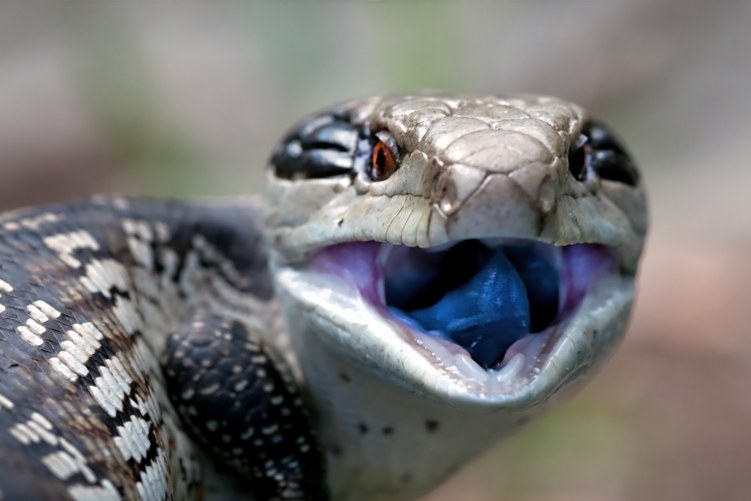 Blue tongue skinks: Blue tongue skinks are a special category of beginner lizard that seem to fulfill the wish list of all the attributes that one would want as a starter reptile. They are touted as easy keepers with obvious intelligence and pleasant personalities. They have simple cage requirements, uncomplicated diets (do not require live food), seem to enjoy handling, are hardy, yet docile, and live to 15-20 years.
Blue tongue skinks: Blue tongue skinks are a special category of beginner lizard that seem to fulfill the wish list of all the attributes that one would want as a starter reptile. They are touted as easy keepers with obvious intelligence and pleasant personalities. They have simple cage requirements, uncomplicated diets (do not require live food), seem to enjoy handling, are hardy, yet docile, and live to 15-20 years.
The Northern blue tongue skink (Tiliqua scincoides intermedia) comes from northern Australia woodlands and grasslands, grows to an adult size of 18”-24”, and needs a cage of at least 36”x18”x10” (length x width x height). Their grassland and forest origin makes them terrestrial rather than tree climbers, so they prefer floor space over climbing perches. They can live in a family arrangement if dwelling in a suitably large enclosure, but if so, they must be watched for signs of fighting. Males should not be housed together. Their habitat should have warmer areas and cooler areas, known as an appropriate thermogradient. Basking areas can be 90-100 degrees and cooler areas 75-82 degrees. They are omnivorous and feed daily or every other day (adults). They are touted as being able to reward owners with their surprising and curious personalities regardless of the level of herp experience. The other most commonly seen blue tongue species in the pet trade is the Indonesian blue tongue (Tiliqua gigas).
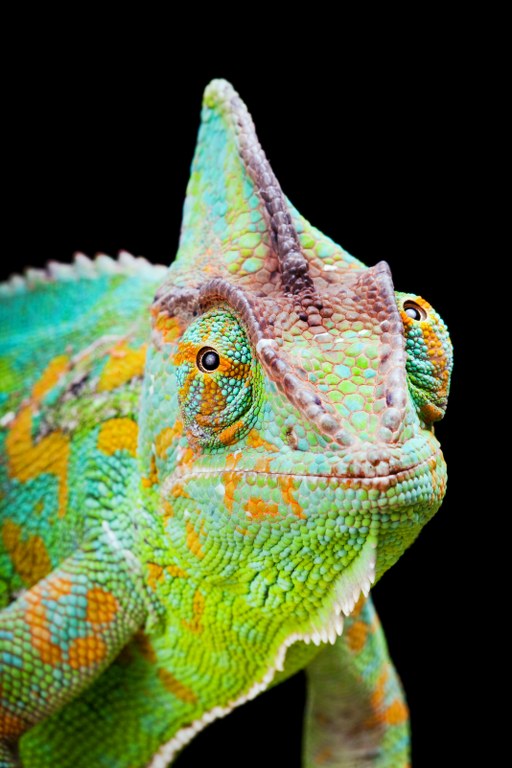 Veiled chameleon (Chamaeleo calyptratus): These impressive lizards hail from Saudi Arabia and Yemen, and are arboreal creatures that you rarely see in photographs on anything other than a tree branch or twig. They grow to 10”-20” and males live for 6-8 years. Female life span is 4-6 years. Herper experience level is rated at moderate to advanced for these reptiles. Cage requirements include a minimum footprint of 24”x24” with a height of at least 36” for climbing. They live in the trees, so the higher the cage, the better. A live ficus is a good selection for climbing in the cage, and monitoring equipment for humidity and temperature levels is greatly helpful. Veiled chameleons are primarily insectivores (older ones will eat some vegetation) with specific feeding requirements. They drink water from droplets that have been misted onto plants or that have landed on their own bodies. They will not drink from water bowls. Misting at least 2 times a day is a must for water consumption. Heat requirements are 72-80 degrees for the cage itself and 88-100 degrees for a basking spot. They also require UVB lighting and vitamin supplementation, but must be able to hide from the UVB lighting. Supplying high humidity with adequate ventilation is a key to keeping this species, as well as many other chameleons. Care is more complex for these pets, but the reward is in their unique beauty and biology.
Veiled chameleon (Chamaeleo calyptratus): These impressive lizards hail from Saudi Arabia and Yemen, and are arboreal creatures that you rarely see in photographs on anything other than a tree branch or twig. They grow to 10”-20” and males live for 6-8 years. Female life span is 4-6 years. Herper experience level is rated at moderate to advanced for these reptiles. Cage requirements include a minimum footprint of 24”x24” with a height of at least 36” for climbing. They live in the trees, so the higher the cage, the better. A live ficus is a good selection for climbing in the cage, and monitoring equipment for humidity and temperature levels is greatly helpful. Veiled chameleons are primarily insectivores (older ones will eat some vegetation) with specific feeding requirements. They drink water from droplets that have been misted onto plants or that have landed on their own bodies. They will not drink from water bowls. Misting at least 2 times a day is a must for water consumption. Heat requirements are 72-80 degrees for the cage itself and 88-100 degrees for a basking spot. They also require UVB lighting and vitamin supplementation, but must be able to hide from the UVB lighting. Supplying high humidity with adequate ventilation is a key to keeping this species, as well as many other chameleons. Care is more complex for these pets, but the reward is in their unique beauty and biology.
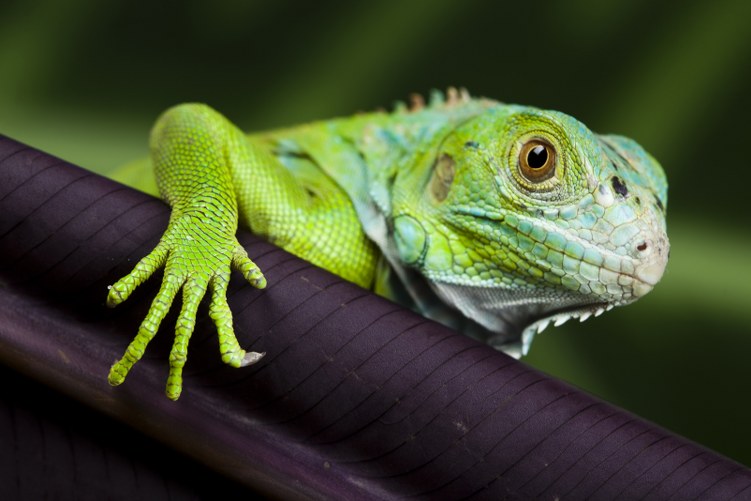 Green iguana (Iguana iguana): These are some of the larger examples of the pet reptile world, found from Mexico and Central America down through South America. Adult males may reach 7’ in length, weighing up to 20 pounds. The sheer size is a preliminary obstacle that discourages most beginners from becoming green iguana owners. Green iguanas are both arboreal and terrestrial. The enclosure for one adult (two males cannot be housed together) should be twice as long and as wide as the iguana itself. Cage minimums for adults are 12’x6’x6’ high, with sturdy mesh fencing around and over the top, or appropriate other caging allowing appropriate ventilation and thermogradient. Smaller cages may be necessary for babies growing, as large pens make it more difficult to find food. Temperature issues are also more complicated with the larger pens, and humidity and moisture challenges exist as well. Nutrition has specific requirements in terms of “do’s” and “do not’s.” UVA and UVB lighting are required, and heat must come from above as iguanas are basking species. If the herper is experienced enough to create good habitat conditions, while meeting nutrition, health and care requirements, then green iguanas can make good pets for many years. With their individual personalities, ability to recognize their keepers and potential to seemingly show affection, they can reward their owners. Read more about the care of green iguana
Green iguana (Iguana iguana): These are some of the larger examples of the pet reptile world, found from Mexico and Central America down through South America. Adult males may reach 7’ in length, weighing up to 20 pounds. The sheer size is a preliminary obstacle that discourages most beginners from becoming green iguana owners. Green iguanas are both arboreal and terrestrial. The enclosure for one adult (two males cannot be housed together) should be twice as long and as wide as the iguana itself. Cage minimums for adults are 12’x6’x6’ high, with sturdy mesh fencing around and over the top, or appropriate other caging allowing appropriate ventilation and thermogradient. Smaller cages may be necessary for babies growing, as large pens make it more difficult to find food. Temperature issues are also more complicated with the larger pens, and humidity and moisture challenges exist as well. Nutrition has specific requirements in terms of “do’s” and “do not’s.” UVA and UVB lighting are required, and heat must come from above as iguanas are basking species. If the herper is experienced enough to create good habitat conditions, while meeting nutrition, health and care requirements, then green iguanas can make good pets for many years. With their individual personalities, ability to recognize their keepers and potential to seemingly show affection, they can reward their owners. Read more about the care of green iguana
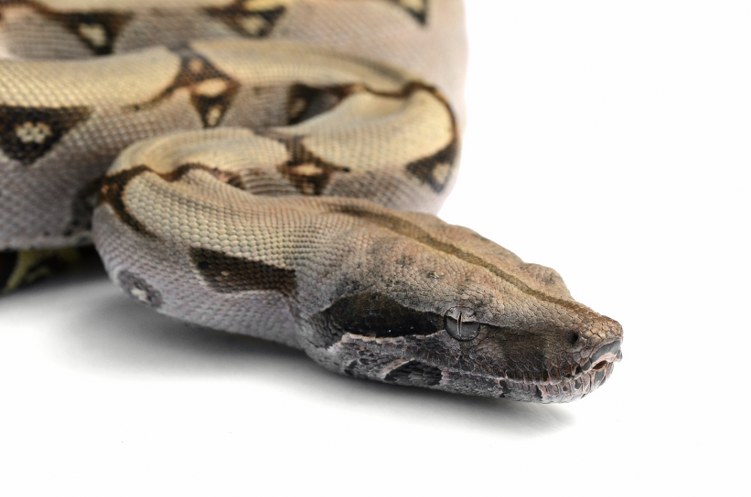 Large constrictor snakes ( large pythons and anacondas): There are a few species of constrictor snakes that require serious consideration and research before bringing home. While the species thrive in captivity, their size, costs to keep, long life spans and the potential requirement of multi-person handling make these species only appropriate for advanced keepers. Only those willing to accept these commitments should consider these large constrictors. The common large snake species include:
Large constrictor snakes ( large pythons and anacondas): There are a few species of constrictor snakes that require serious consideration and research before bringing home. While the species thrive in captivity, their size, costs to keep, long life spans and the potential requirement of multi-person handling make these species only appropriate for advanced keepers. Only those willing to accept these commitments should consider these large constrictors. The common large snake species include:
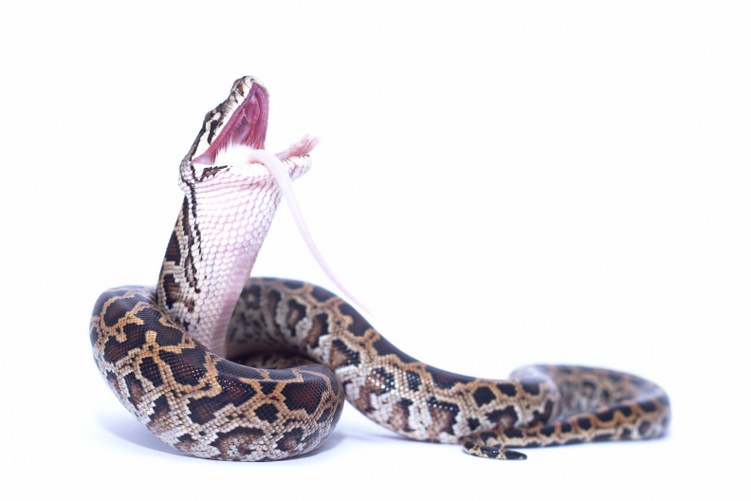 Of these, the Burmese and reticulated pythons are the most commonly found constricting snakes in the pet trade. The commitment and dedication required to keep these species are significant. People who are unprepared and unqualified to handle them as adults should not acquire these species. These are not pets for beginners. The enclosure for these snakes must be escape-proof and for additional security, the house or room that the cage is kept in should be securely sealed as well. Large constrictors are powerful creatures and should be kept only in enclosures specifically made to house them. They should also be housed separately. While basic responsible handling and housing protocols can eliminate any risk of incident from these species, potential owners must be familiar with, and educated on these procedures. Their feeding routines and care are also beyond the scope of the beginner herper. As pets, they should not be undertaken until a few years of experience are accumulated in smaller reptile pet species keeping, or after someone has worked in a facility keeping these species and has earned time interacting with them. At minimum, these snakes require cages providing 1-2’ of floor space for every foot of snake. Read more about the handling of these constricting snakes here.
Of these, the Burmese and reticulated pythons are the most commonly found constricting snakes in the pet trade. The commitment and dedication required to keep these species are significant. People who are unprepared and unqualified to handle them as adults should not acquire these species. These are not pets for beginners. The enclosure for these snakes must be escape-proof and for additional security, the house or room that the cage is kept in should be securely sealed as well. Large constrictors are powerful creatures and should be kept only in enclosures specifically made to house them. They should also be housed separately. While basic responsible handling and housing protocols can eliminate any risk of incident from these species, potential owners must be familiar with, and educated on these procedures. Their feeding routines and care are also beyond the scope of the beginner herper. As pets, they should not be undertaken until a few years of experience are accumulated in smaller reptile pet species keeping, or after someone has worked in a facility keeping these species and has earned time interacting with them. At minimum, these snakes require cages providing 1-2’ of floor space for every foot of snake. Read more about the handling of these constricting snakes here.
_751x673.jpg) Greek Tortoise: Everyone knows tortoises are not racehorses – they shouldn’t need the same diet as a high powered, active animal. But years ago, owners thought they would grow larger and faster if they fed higher protein; dog and cat food was the training diet of choice. Wrong. As herbivores, higher protein actually can be harmful. Greek tortoises enjoy leafy greens and perhaps chopped timothy hay to keep their beaks trimmed. Small amounts of chopped fruits can make up about 10% of their diet. A low protein diet high in fiber with regular calcium dusting suits them just fine. Greek tortoises can live up to 50 years or more, grow up to 10 inches in length, need UVB and heat lighting, preferably overhead with enclosure temperature around 75 degrees and basking temperatures about 95 degrees. Caging needs to be ample and can range from custom built enclosures to tubs to large fish tanks. They can also spend some time outside during the summer, but must be carefully caged and watched to prevent escape or becoming the target of a predator (yes, escape - they’re faster than you think they are and they’re experts at hiding). Read more about Greek Tortoise care here and here.
Greek Tortoise: Everyone knows tortoises are not racehorses – they shouldn’t need the same diet as a high powered, active animal. But years ago, owners thought they would grow larger and faster if they fed higher protein; dog and cat food was the training diet of choice. Wrong. As herbivores, higher protein actually can be harmful. Greek tortoises enjoy leafy greens and perhaps chopped timothy hay to keep their beaks trimmed. Small amounts of chopped fruits can make up about 10% of their diet. A low protein diet high in fiber with regular calcium dusting suits them just fine. Greek tortoises can live up to 50 years or more, grow up to 10 inches in length, need UVB and heat lighting, preferably overhead with enclosure temperature around 75 degrees and basking temperatures about 95 degrees. Caging needs to be ample and can range from custom built enclosures to tubs to large fish tanks. They can also spend some time outside during the summer, but must be carefully caged and watched to prevent escape or becoming the target of a predator (yes, escape - they’re faster than you think they are and they’re experts at hiding). Read more about Greek Tortoise care here and here.
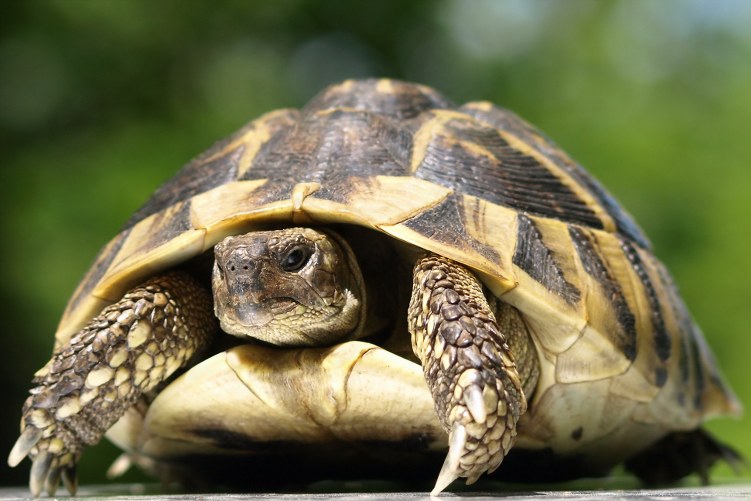 Hermann’s tortoise: Another of the Mediterranean tortoise family, Hermann’s tortoises are more active and better escape artists than the Greek tortoises. Caging should be at least 2’ x 4’ and should also be buried to prevent digging out from under and escaping. Care should also be focused on the sides and top of the caging, as Hermann’s tortoises will climb, too (yes, cover with chicken wire or other escape-proof netting). They are not large, grow to 6-8” and their life span is up to 75 years or more. Be ready for a lengthy companionship! Their diet is leafy greens, supplemented with other vegetables and fruits with calcium and vitamin D3 added regularly and if kept indoors, they should have UVB lighting along with basking light. They love the outdoors if it is between 80-86 degrees daytime and if nights don’t fall below 65 degrees. If indoors, they should have a basking spot of about 95 degrees, with a soil/sand mix or cypress bark substrate and a shallow water pan. They hibernate! Many tortoises will not hibernate if taken from the wild and kept indoors, but the Hermann’s tortoise will do so, and needs accommodations for hibernating and proper care when the long sleep is over. Read more about caring for the Herman tortoise here and here.
Hermann’s tortoise: Another of the Mediterranean tortoise family, Hermann’s tortoises are more active and better escape artists than the Greek tortoises. Caging should be at least 2’ x 4’ and should also be buried to prevent digging out from under and escaping. Care should also be focused on the sides and top of the caging, as Hermann’s tortoises will climb, too (yes, cover with chicken wire or other escape-proof netting). They are not large, grow to 6-8” and their life span is up to 75 years or more. Be ready for a lengthy companionship! Their diet is leafy greens, supplemented with other vegetables and fruits with calcium and vitamin D3 added regularly and if kept indoors, they should have UVB lighting along with basking light. They love the outdoors if it is between 80-86 degrees daytime and if nights don’t fall below 65 degrees. If indoors, they should have a basking spot of about 95 degrees, with a soil/sand mix or cypress bark substrate and a shallow water pan. They hibernate! Many tortoises will not hibernate if taken from the wild and kept indoors, but the Hermann’s tortoise will do so, and needs accommodations for hibernating and proper care when the long sleep is over. Read more about caring for the Herman tortoise here and here.
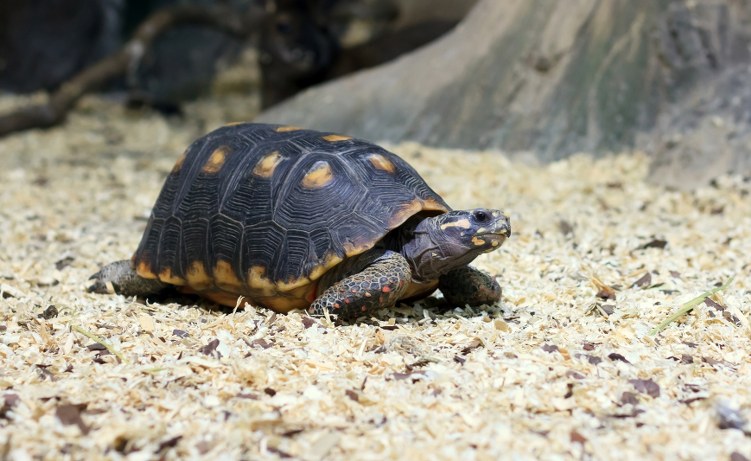 Russian tortoise: Yes, they are from Russia! They’re also found in Afghanistan, Uzbekistan, Northern Pakistan, Northern and Eastern Iran and Northwestern China. If it sounds like rocky desert digs may be homes for Russian Tortoises, you’re right. They live in sandy desert areas without much grass or bush cover. They typically burrow to make homes, and in the wild, hibernate during the winter and estivate during the hottest part of the summer. They grow to a length of 10-11 inches and can live for more than 40 years. They’re a popular tortoise pet selection because they are readily available, small, eager eaters and are more active than other tortoises. But that also means busier burrowers! Because they love digging, they must be kept in caging that is buried at least 6 to 12 inches to prevent escapes; enclosures for adults should be at least 2’ x 4’. Their burrowing enables them to withstand a wider range of temperatures than other tortoise pets; they are one of the few that can be kept outdoors in Nevada or New Mexico desert climates year round. If you build a hiding box underground they’ll make that their burrow home and not play The Great Escape so much. Read more about caring for the Russian tortoise here.
Russian tortoise: Yes, they are from Russia! They’re also found in Afghanistan, Uzbekistan, Northern Pakistan, Northern and Eastern Iran and Northwestern China. If it sounds like rocky desert digs may be homes for Russian Tortoises, you’re right. They live in sandy desert areas without much grass or bush cover. They typically burrow to make homes, and in the wild, hibernate during the winter and estivate during the hottest part of the summer. They grow to a length of 10-11 inches and can live for more than 40 years. They’re a popular tortoise pet selection because they are readily available, small, eager eaters and are more active than other tortoises. But that also means busier burrowers! Because they love digging, they must be kept in caging that is buried at least 6 to 12 inches to prevent escapes; enclosures for adults should be at least 2’ x 4’. Their burrowing enables them to withstand a wider range of temperatures than other tortoise pets; they are one of the few that can be kept outdoors in Nevada or New Mexico desert climates year round. If you build a hiding box underground they’ll make that their burrow home and not play The Great Escape so much. Read more about caring for the Russian tortoise here.
_751x501.jpg) Sulcate or spur-thigh tortoise: These are one of the elephants of the tortoise world: African desert in native habitat, they can grow to 200+ pounds and lengths of 33” and can reach 100 yrs of age. They are the third largest of the tortoise family and the largest continental tortoise (the 2 larger species are on islands). The average size of an adult as a pet is around 70-90 pounds, as they tend to grow rapidly for the first 5 to 10 years and then very slowly as they age. At 5 to 10 years they could be as small as 10” but growth rates and sizes vary on an individual basis. Best to keep in mind that they will grow to very large size and with that, they are very strong animals. They’re a desert origin animal, so burrowing is second nature to them – they can dig up to 30’ burrows to escape the heat with no trouble. They can also burrow the length of an enclosure too; something to plan for in constructing a home for them (think about a concrete block perimeter set below the surface). They should have a solid wall above the ground too, as visual attractions outside may cause burrowing to escape. inside a cage or indoors, they have moderate temperature, water and basking needs, are herbivores and require vitamin and calcium additions to their diet as well as UVB lighting if indoors. They do not hibernate and tolerate different dry climates well, but even with their desert background, should not be exposed to outside temperatures below 65 degrees or over 100 degrees: daytime temperatures of 75-85 degrees are optimal. They are herbivores and seek a grass-based diet and should not be fed fruit, as the excess sugar can disrupt their digestive system. Remember, these are big guys, and taking one on as a pet is a considerably big project. Read more about how to care for an African Sulcata tortoise here.
Sulcate or spur-thigh tortoise: These are one of the elephants of the tortoise world: African desert in native habitat, they can grow to 200+ pounds and lengths of 33” and can reach 100 yrs of age. They are the third largest of the tortoise family and the largest continental tortoise (the 2 larger species are on islands). The average size of an adult as a pet is around 70-90 pounds, as they tend to grow rapidly for the first 5 to 10 years and then very slowly as they age. At 5 to 10 years they could be as small as 10” but growth rates and sizes vary on an individual basis. Best to keep in mind that they will grow to very large size and with that, they are very strong animals. They’re a desert origin animal, so burrowing is second nature to them – they can dig up to 30’ burrows to escape the heat with no trouble. They can also burrow the length of an enclosure too; something to plan for in constructing a home for them (think about a concrete block perimeter set below the surface). They should have a solid wall above the ground too, as visual attractions outside may cause burrowing to escape. inside a cage or indoors, they have moderate temperature, water and basking needs, are herbivores and require vitamin and calcium additions to their diet as well as UVB lighting if indoors. They do not hibernate and tolerate different dry climates well, but even with their desert background, should not be exposed to outside temperatures below 65 degrees or over 100 degrees: daytime temperatures of 75-85 degrees are optimal. They are herbivores and seek a grass-based diet and should not be fed fruit, as the excess sugar can disrupt their digestive system. Remember, these are big guys, and taking one on as a pet is a considerably big project. Read more about how to care for an African Sulcata tortoise here.
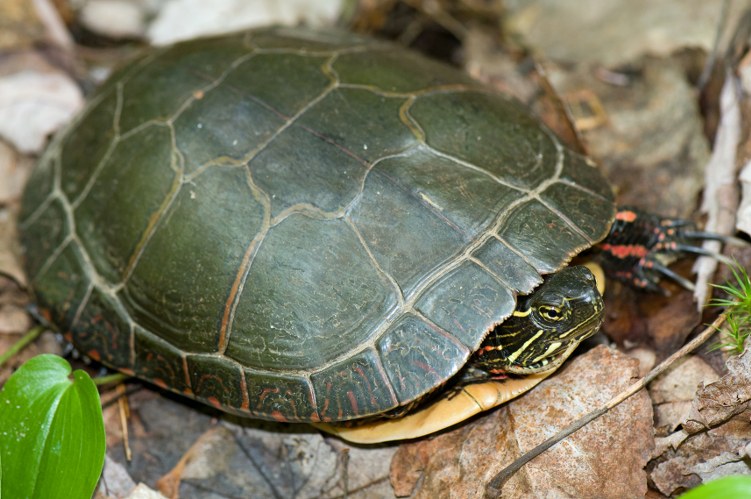 Painted turtle: These may be the perfect starter turtle pet. They’re small, require moderate caging essentials, are active and colorfully marked and can enjoy both inside and outside enclosures (depending on the season and conditions outside). They are native to the entire lower 48 U.S. states, with habitat ranging from the west coast to the east coast and from Canada to Mexico. There are 4 types with minor differences depending on the section of the country, but overall they reach 4”-6” in length and have been known to live for as long as 50 years, with an average life span of 25-30 years. They’re found in fresh water ponds and slow water portions of streams, so they require water and hiding spots as well as basking areas for their caging. If outside, they also require protection from predators. They’re omnivores, they can eat live food as well as greens; they’re able swimmers; their temperature needs are water at 75-80 degrees, habitat at 80-85 degrees and basking areas at 85-95 degrees. If they have sufficient dietary calcium and vitamin D3, they can get along without UVA/UVB interior lighting (most pet owners supplement with it anyway). Since painted turtles are native throughout the U.S., it is especially important to check with your state laws in connection with owning one: some states have restrictions on ownership aimed at preventing non-native types of painted turtles from invading the native type area (western, eastern, southern and midland are the 4 type areas). Read more about how to care for a painted turtle.
Painted turtle: These may be the perfect starter turtle pet. They’re small, require moderate caging essentials, are active and colorfully marked and can enjoy both inside and outside enclosures (depending on the season and conditions outside). They are native to the entire lower 48 U.S. states, with habitat ranging from the west coast to the east coast and from Canada to Mexico. There are 4 types with minor differences depending on the section of the country, but overall they reach 4”-6” in length and have been known to live for as long as 50 years, with an average life span of 25-30 years. They’re found in fresh water ponds and slow water portions of streams, so they require water and hiding spots as well as basking areas for their caging. If outside, they also require protection from predators. They’re omnivores, they can eat live food as well as greens; they’re able swimmers; their temperature needs are water at 75-80 degrees, habitat at 80-85 degrees and basking areas at 85-95 degrees. If they have sufficient dietary calcium and vitamin D3, they can get along without UVA/UVB interior lighting (most pet owners supplement with it anyway). Since painted turtles are native throughout the U.S., it is especially important to check with your state laws in connection with owning one: some states have restrictions on ownership aimed at preventing non-native types of painted turtles from invading the native type area (western, eastern, southern and midland are the 4 type areas). Read more about how to care for a painted turtle.
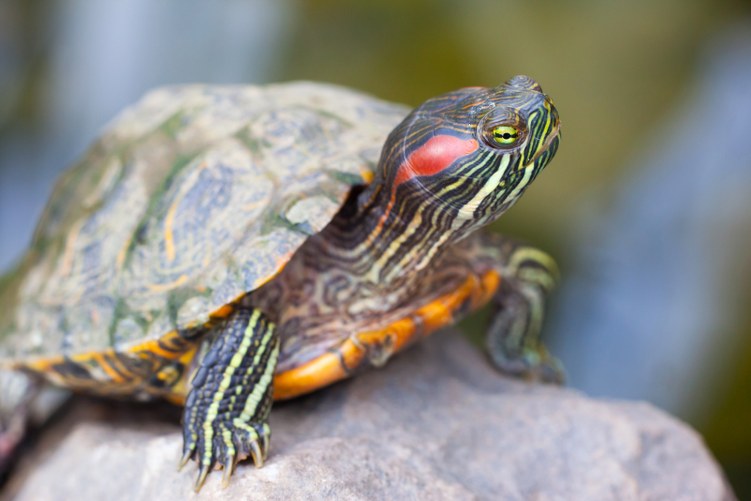 Red-eared slider turtle: These turtles are common in fresh water in the U.S. from Illinois to the Gulf of Mexico and from the East Coast to West Texas. The name comes from the red marking behind the eye and the “slider” comes from their habit of sliding off their basking place when startled – the slide off into the water and swim away. These are semi-aquatic turtles, with swimming needs that call for 10 gallons of water for every inch of turtle length and an area for basking as well; they need large tanks for their size. Water depth is also a consideration as the need approximately 1 ½ times their length in water depth (and they grow to 10-12 inches as adults, and reach an age of about 40 years) the length of the water area should be 5 times the length of the turtle, with a system that enables getting out of the water for basking and insures that no underwater hazard traps exist to prevent getting out of the pool. Water filtration is a necessity with red eared sliders, and water changes of about ¼ volume are necessary weekly, with thorough container cleaning a monthly duty. Water temperatures should range from 75-78 degrees for adults and 78-80 degrees for hatchlings; ambient temperature in the enclosure should be 75-80 degrees and basking spots should be 90-95 degrees. Lighting needs include UVA/UVB exposure. Be sure to check with your state regulations that may impact purchasing and keeping red-eared sliders.
Red-eared slider turtle: These turtles are common in fresh water in the U.S. from Illinois to the Gulf of Mexico and from the East Coast to West Texas. The name comes from the red marking behind the eye and the “slider” comes from their habit of sliding off their basking place when startled – the slide off into the water and swim away. These are semi-aquatic turtles, with swimming needs that call for 10 gallons of water for every inch of turtle length and an area for basking as well; they need large tanks for their size. Water depth is also a consideration as the need approximately 1 ½ times their length in water depth (and they grow to 10-12 inches as adults, and reach an age of about 40 years) the length of the water area should be 5 times the length of the turtle, with a system that enables getting out of the water for basking and insures that no underwater hazard traps exist to prevent getting out of the pool. Water filtration is a necessity with red eared sliders, and water changes of about ¼ volume are necessary weekly, with thorough container cleaning a monthly duty. Water temperatures should range from 75-78 degrees for adults and 78-80 degrees for hatchlings; ambient temperature in the enclosure should be 75-80 degrees and basking spots should be 90-95 degrees. Lighting needs include UVA/UVB exposure. Be sure to check with your state regulations that may impact purchasing and keeping red-eared sliders.
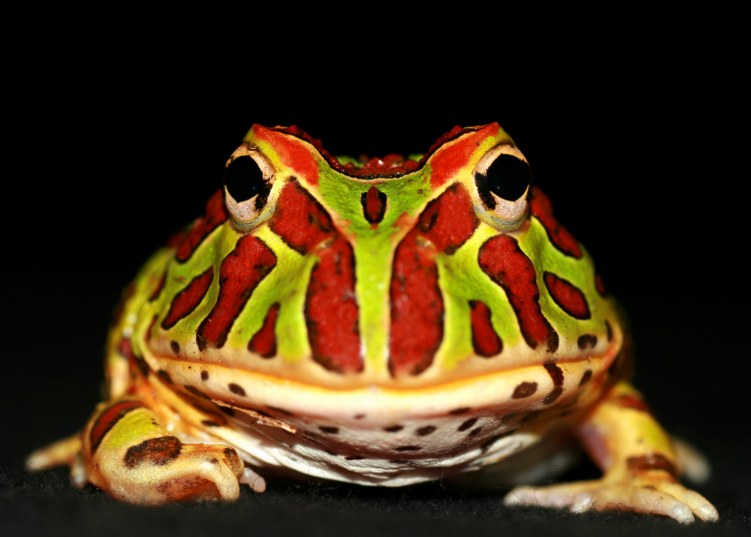 Pacman frog: The name obviously comes from the popular video game because it actually LOOKS and ACTS like Pac-Man as an adult – round body with a huge mouth that eats almost anything that moves. Pacman frogs sold as pets are about the size of a quarter, but adult females can reach 4-7” in length (males are much smaller – about 2 ½” to 4”), and they can live with you as a pet for about 15 years. They are also called horned frogs and ornate horned frogs because of the skin projections over their eyes. Natives of South America, they are commonly available pets in the U.S., selected for their interesting appearance, relatively simple caging and moderately easy care. Their feeding practice is ambush: they will burrow in substrate up to their eyes and wait for food to come within striking distance. And they are voracious eaters. Cautions abound about making sure your Pacman doesn’t get too large, with the remedy being simply cutting down on the food source. They thrive in 68-80 degree heat with humidity, soe misting, and basking heat of around 100 degrees. Some odd facts: they have teeth and are sometimes called aggressive, but the reason for their biting is because if it moves, they generally eat it – including your finger if it’s wiggling in front of them (they’re not the best to handle). And oddity number 2: if it gets too cold or dry for them, they will dry out, toughen their skin and can go into a brumation state (like hibernation but not actually hibernating). They will come out of it if the humidity and temperature increases, at which time they will shed their toughened skin and eat THAT (they eat a lot, including pinkie mice – or anything else in their cage, including smaller Pacman frogs). Read more about how to care for a Pacman frog.
Pacman frog: The name obviously comes from the popular video game because it actually LOOKS and ACTS like Pac-Man as an adult – round body with a huge mouth that eats almost anything that moves. Pacman frogs sold as pets are about the size of a quarter, but adult females can reach 4-7” in length (males are much smaller – about 2 ½” to 4”), and they can live with you as a pet for about 15 years. They are also called horned frogs and ornate horned frogs because of the skin projections over their eyes. Natives of South America, they are commonly available pets in the U.S., selected for their interesting appearance, relatively simple caging and moderately easy care. Their feeding practice is ambush: they will burrow in substrate up to their eyes and wait for food to come within striking distance. And they are voracious eaters. Cautions abound about making sure your Pacman doesn’t get too large, with the remedy being simply cutting down on the food source. They thrive in 68-80 degree heat with humidity, soe misting, and basking heat of around 100 degrees. Some odd facts: they have teeth and are sometimes called aggressive, but the reason for their biting is because if it moves, they generally eat it – including your finger if it’s wiggling in front of them (they’re not the best to handle). And oddity number 2: if it gets too cold or dry for them, they will dry out, toughen their skin and can go into a brumation state (like hibernation but not actually hibernating). They will come out of it if the humidity and temperature increases, at which time they will shed their toughened skin and eat THAT (they eat a lot, including pinkie mice – or anything else in their cage, including smaller Pacman frogs). Read more about how to care for a Pacman frog.
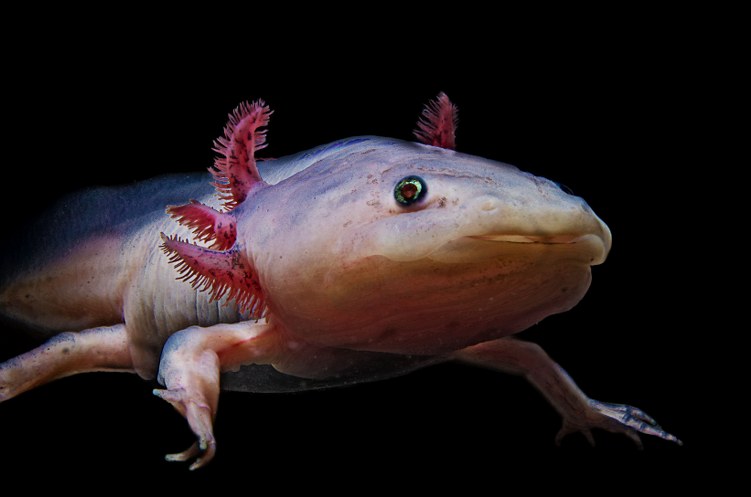 Axolotl: Like starfish, the Axolotl can grow a new limb! That’s not the reason people choose them for pets, but it’s one of the quirks that make them both protected from extinction and valuable for research (Captan Hook would have loved to have the answer!) Axolotl are native to Mexico, and may look like their northern mud puppy salamander relatives, but the occupy a specific place in both taxonomy and habitat. Their native lakes are near Mexico City, Lake Xochimilco and Lake Chalco – both were high altitude fresh water lakes before Mexico City expansion, but now only canal remnants of Lake Xochimilco exist. Consequently they are listed on the CITES endangered species list. Fortunately, more than enough Axolotl are raised domestically to avoid extinction, but native habitat and wild reproduction remains a problem. They could be viewed as a salamander work in progress, as they go from egg to larva as frogs do from eggs to larva (tadpoles), but they stop at the larval stage and grow to adult size and complete their life cycle as larvae. They keep their gills and fins and do not develop adult characteristics of salamanders; it reaches sexual maturity and reproduces in its larval form, remaining completely aquatic for its entire life cycle. They come in a wide range of colors, from albino to black with almost everything in between, including piebald. They are relatively easy keepers, requiring simple, cool container tanks for caging (chlorine removal and not using high powered water cleaning filters are reqirements). They are not pets that you can handle safely, as the gills are tender, and their live food diet means that juveniles will go after one another and as adults they may need separation from others.
Axolotl: Like starfish, the Axolotl can grow a new limb! That’s not the reason people choose them for pets, but it’s one of the quirks that make them both protected from extinction and valuable for research (Captan Hook would have loved to have the answer!) Axolotl are native to Mexico, and may look like their northern mud puppy salamander relatives, but the occupy a specific place in both taxonomy and habitat. Their native lakes are near Mexico City, Lake Xochimilco and Lake Chalco – both were high altitude fresh water lakes before Mexico City expansion, but now only canal remnants of Lake Xochimilco exist. Consequently they are listed on the CITES endangered species list. Fortunately, more than enough Axolotl are raised domestically to avoid extinction, but native habitat and wild reproduction remains a problem. They could be viewed as a salamander work in progress, as they go from egg to larva as frogs do from eggs to larva (tadpoles), but they stop at the larval stage and grow to adult size and complete their life cycle as larvae. They keep their gills and fins and do not develop adult characteristics of salamanders; it reaches sexual maturity and reproduces in its larval form, remaining completely aquatic for its entire life cycle. They come in a wide range of colors, from albino to black with almost everything in between, including piebald. They are relatively easy keepers, requiring simple, cool container tanks for caging (chlorine removal and not using high powered water cleaning filters are reqirements). They are not pets that you can handle safely, as the gills are tender, and their live food diet means that juveniles will go after one another and as adults they may need separation from others.
 This guide proudly presented as part of NAIA's mission to preserve and protect domestic animals. This guide proudly presented as part of NAIA's mission to preserve and protect domestic animals.
|
 Discover Animals is a web-based educational resource offered by the NAIA
Discover Animals is a web-based educational resource offered by the NAIA